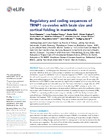Regulatory and coding sequences of TRNP1 co-evolve with brain size and cortical folding in mammals
dc.contributor.author
Kliesmete, Zane
dc.contributor.author
Wange, Lucas Esteban
dc.contributor.author
Vieth, Beate
dc.contributor.author
Esgleas, Miriam
dc.contributor.author
Radmer, Jessica
dc.contributor.author
Hülsmann, Matthias
dc.contributor.author
Geuder, Johanna
dc.contributor.author
Richter, Daniel
dc.contributor.author
Ohnuki, Mari
dc.contributor.author
Götz, Magdelena
dc.contributor.author
Hellmann, Ines
dc.contributor.author
Enard, Wolfgang
dc.date.accessioned
2023-04-05T08:30:18Z
dc.date.available
2023-04-02T06:53:06Z
dc.date.available
2023-04-05T08:30:18Z
dc.date.issued
2023-03-22
dc.identifier.issn
2050-084X
dc.identifier.other
10.7554/eLife.83593
en_US
dc.identifier.uri
http://hdl.handle.net/20.500.11850/606129
dc.identifier.doi
10.3929/ethz-b-000606129
dc.description.abstract
Brain size and cortical folding have increased and decreased recurrently during mammalian evolution. Identifying genetic elements whose sequence or functional properties co-evolve with these traits can provide unique information on evolutionary and developmental mechanisms. A good candidate for such a comparative approach is TRNP1, as it controls proliferation of neural progenitors in mice and ferrets. Here, we investigate the contribution of both regulatory and coding sequences of TRNP1 to brain size and cortical folding in over 30 mammals. We find that the rate of TRNP1 protein evolution (ω) significantly correlates with brain size, slightly less with cortical folding and much less with body size. This brain correlation is stronger than for >95% of random control proteins. This co-evolution is likely affecting TRNP1 activity, as we find that TRNP1 from species with larger brains and more cortical folding induce higher proliferation rates in neural stem cells. Furthermore, we compare the activity of putative cis-regulatory elements (CREs) of TRNP1 in a massively parallel reporter assay and identify one CRE that likely co-evolves with cortical folding in Old World monkeys and apes. Our analyses indicate that coding and regulatory changes that increased TRNP1 activity were positively selected either as a cause or a consequence of increases in brain size and cortical folding. They also provide an example how phylogenetic approaches can inform biological mechanisms, especially when combined with molecular phenotypes across several species.
en_US
dc.format
application/pdf
en_US
dc.language.iso
en
en_US
dc.publisher
eLife Sciences Publications
dc.rights.uri
http://creativecommons.org/licenses/by/4.0/
dc.title
Regulatory and coding sequences of TRNP1 co-evolve with brain size and cortical folding in mammals
en_US
dc.type
Journal Article
dc.rights.license
Creative Commons Attribution 4.0 International
ethz.journal.title
eLife
ethz.journal.volume
12
en_US
ethz.pages.start
e83593
en_US
ethz.size
29 p.
en_US
ethz.version.deposit
publishedVersion
en_US
ethz.identifier.wos
ethz.identifier.scopus
ethz.publication.place
Cambridge
ethz.publication.status
published
en_US
ethz.date.deposited
2023-04-02T06:53:06Z
ethz.source
SCOPUS
ethz.eth
yes
en_US
ethz.availability
Open access
en_US
ethz.rosetta.installDate
2023-04-05T08:30:19Z
ethz.rosetta.lastUpdated
2024-02-02T21:31:22Z
ethz.rosetta.versionExported
true
ethz.COinS
ctx_ver=Z39.88-2004&rft_val_fmt=info:ofi/fmt:kev:mtx:journal&rft.atitle=Regulatory%20and%20coding%20sequences%20of%20TRNP1%20co-evolve%20with%20brain%20size%20and%20cortical%20folding%20in%20mammals&rft.jtitle=eLife&rft.date=2023-03-22&rft.volume=12&rft.spage=e83593&rft.issn=2050-084X&rft.au=Kliesmete,%20Zane&Wange,%20Lucas%20Esteban&Vieth,%20Beate&Esgleas,%20Miriam&Radmer,%20Jessica&rft.genre=article&rft_id=info:doi/10.7554/eLife.83593&
Files in this item
Publication type
-
Journal Article [128962]

